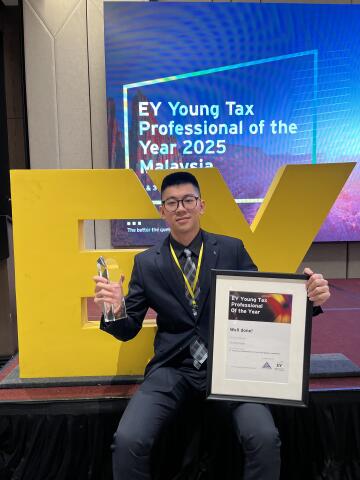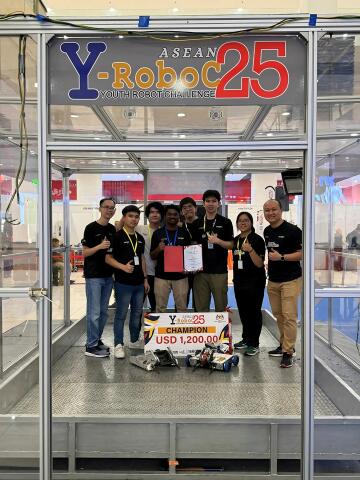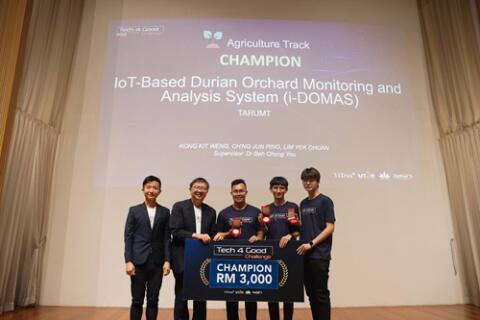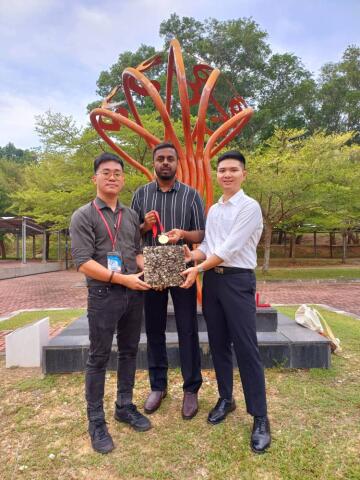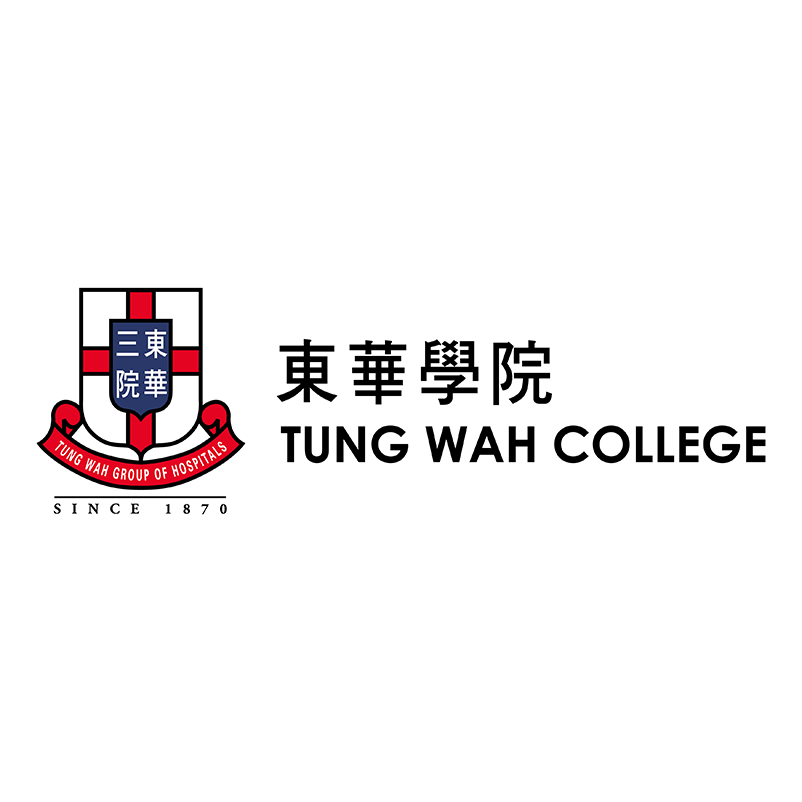FIRST PLACE AT THE KEYSIGHT IOT INNOVATION CHALLENGE FINALS IN NEW YORK

Keysight Technologies Chief Marketing Officer Marie Hattar (left) and Keysight Technologies Portfolio Marketing Senior Director Joel Conover presenting the winning prize of USD25,000 to Au Jin Cheng and Lim Wen Qing (second and third from left)
UTAR Lee Long Chian Faculty of Engineering and Science students Lim Wen Qing, Au Jin Cheng, Yap Sheng Yao, Tan Kai Siang and Khor Jun Bin won first (1st) place in the Smart Water category at the finals of the Keysight IoT Innovation Challenge held in New York, USA from 21 to 22 September 2019. The winning prize was USD25,000 and Keysight test equipment worth USD25,000. Keysight Technologies Inc sponsored two students from the UTAR team, Lim Wen Qing and Au Jin Cheng for an all-expenses paid trip to New York covering the airfare, accommodation, meals and transportation, to present their invention at the finals before a team of judges.
The Keysight IoT Innovation Challenge is a design competition that challenges engineering students worldwide to conceptualise low-power sensor networks to tackle issues brought on by today’s rapid urbanisation. The competition had two tracks/categories, namely The Smart Land challenge and The Smart Water challenge and the challenge was open to all countries in the region of Asia Pacific and Greater China, Europe, and the USA.
The UTAR students invented a smart device that can monitor water pollutants in rivers and lakes with readings that can be downloaded (through an app) by the community to monitor the quality of water. This device, titled the IoT Detachable Waterway Monitoring Device with LoRa and Self-Sustainability, uses natural energy sources from the sun, wind and water. It is truly an ingenious invention with much engineering and scientific principles applied.
The team members, at the idea conception and construction stages, worked rather independently on their own, seeking assistance for supporting resources from their advisor and lecturer Ir Danny Ng Wee Kiat. They spent hours and brainstorming sessions looking into the intricacies of the device to ensure that the model is tested for practicality and precision.

Jin Cheng (left) and Wen Qing, receiving the prize on behalf of the team, from Joel Conover

The UTAR team inventors of the IoT Detachable Waterway Monitoring Device (From left): Ir Danny Ng, Khor Jun Bin, Au Jin Cheng, Lim Wen Qing, Yap Sheng Yao and Tan Kai Siang
The preliminary stage of the Keysight IoT Innovation Challenge required participants to present their design ideas via online written and video submissions. It saw the participation of universities from three regions, namely the United States, Europe, and Asia-Pacific & Greater China. The preliminary stage attracted nearly 300 entries worldwide in both tracks.
Among the countries which participated in the Asia-Pacific and Greater China region were Australia, China, Malaysia, New Zealand, Singapore, South Korea, Taiwan and Thailand. Within this region, more than 30 universities took part in the competition. From Malaysia alone, 10 universities, both public and private, participated in this challenge. Ultimately, the UTAR team was the only team selected as the finalist from the Asia-Pacific and Greater China region.
A total of six teams from both tracks (Smart Land and Smart Water), including UTAR, advanced to the final stage. The other five finalists were student teams from Massachusetts Institute of Technology (MIT, USA), Stanford University (USA), Massey University (New Zealand), Institute of Engineering & Management (India), and the University of Technology of Compiègne (France).

From left: Au, Lim, Joel Conover and Keysight Technologies Test Gear Expert and Content Strategist Daniel Bogdanoff
UTAR team’s winning entry, the IoT Detachable Waterway Monitoring Device with LoRa and Self-Sustainability, is a system device that consists of four major component functions which are, monitoring of the water contents— its acidity, temperature, turbidity, etc; reporting of the data using peer-to-peer LoRa Mesh network; analysis of data collected in the cloud using machine learning algorithm; and energy harvesting system which includes solar, hydro and wind energy for self-sustainability of the device.
According to the team, the node to node communication present in each device enables it to form a large sensor monitoring network. Moreover, Machine Learning is used to analyse the data collected for anomaly detection. The data collected can be used to predict the future condition of waterways for preventive purposes. It is self-sustainable with the help of renewable energy integrated into the system. The monitoring device is modular and can be modified based on the environment. Another feature of the system device also allows the public and community to report on any pollution found in waters, hence making it more community-driven.
By creating a massive monitoring network, the team believes that the system will be able to monitor every single point from all around the world and an immediate response can be taken whenever the water quality reaches a critical stage.
The concept and idea, according to the UTAR winning team, was inspired by the recent water pollution and contamination incident that took place in the state of Johor, Malaysia. Over 2,500 people were affected by gas poisoning and 111 schools were closed as a result of illegally dumped chemical wastes in the river. With a great concern to help solve this problem to prevent the people and the environment from suffering the same fate again in the future, the UTAR team discussed in great length and came up with this brilliant invention to help monitor and report on the quality of water in the waterways.


The IoT Detachable Waterway Monitoring Device being tested at the Kuala Selangor River for 1 week
Wen Qing said that, “In my opinion, the two possible reasons why we won this competition are that firstly, this device was created in relation to an actual problem that took place in Malaysia. Secondly, this device is modular. We have incorporated three energy harvesting systems to charge the battery. They are solar, hydro and wind energy. The solar panels, wind turbine and water turbine are detachable. Only the necessary parts will be installed on the device depending on the environment. For example, in the forest, solar and wind energy are not reliable. Thus, only a water turbine is attached to the device.”
He added further that, “This device was put to actual test on a river and it worked. We spent one week to test out the device in the Kuala Selangor River. The judges were also impressed that this device is very much community-oriented. People can easily report on any pollution found in waters by merely using an app. They can easily gain access to the data (condition of water) as well.”
He elaborated that the most amazing feat was that this device was created and built from scratch with support from the University. The process itself was educational and the team members were very hardworking and focussed. The collaborative teamwork to design and put all pieces together eventually was truly gratifying in the end.
Wen Qing, on behalf of his team, said, “I find the idea behind this challenge very useful as it greatly benefits the society and it looks into sustainability. The challenge was well organised and professionally implemented despite being held for the first time. Personally, it was an amazing experience. My team members and I feel very fortunate to have won this challenge.”
The team’s adviser and lecturer, Ir Danny Ng said that, “The IoT Keysight Challenge presented an opportunity for the students to compete with others on the world stage. The opportunity presented also enabled our students to compete and interact with students from other international universities during the time spent in New York. Through this challenge our students also gained valuable technical knowledge that will enhance their employability.”
At the finals in New York, the students demonstrated their design and systems device at a live-streamed event before a panel of esteemed judges. These judges include United Nations Public Information Officer Ariel Alexovich, Founder & CEO of LunaSonde-cum-Student Innovator Jeremiah Pate, Electrical Engineer and YouTube star a.k.a. “ElectroBOOM” Mehdi Sadaghdar, Senior Technical Editor for Aspencore Media Martin Rowe, Keysight Corporate and Portfolio Marketing Vice President Jeff Harris, General Manager of Keysight Electronic Industrial Products Christopher Cain, and Keysight Education & General Electronics Measurement Solutions Vice President Ee Huei Sin.

Wen Qing presenting the team’s IoT Detachable Waterway Monitoring systems to the panel of judges
UTAR is a not-for-profit university, so the students did not have access to huge funding for a start. However, these students were ingenious and resourceful. With much hard work and determination, they exceled and built the device using existing resources available to them. They also managed to source a sponsor who lent them testing equipment for the device. These students have brought much pride to their friends in the faculty, their family, the university and the country. Well done.
For more information on Keysight’s IoT Innovation Challenge, check out the event website at https://www.iotchallengekeysight.com/. A video on the competition is available here.
Keysight Technologies, Inc. is a leading technology company that helps enterprises, service providers and governments accelerate innovation to connect and secure the world. Keysight's solutions optimise networks and bring electronic products to market faster and at a lower cost with offerings from design simulation, to prototype validation, to manufacturing test, to optimisation in networks and cloud environments. Customers span the worldwide communications ecosystem, aerospace and defence, automotive, energy, semiconductor, and general electronics end markets. With the IoT Innovation Challenge, Keysight is looking for next-generation engineers who can think big and small to innovate solutions to the challenges that arise in this ever-changing world.

The IoT Innovation Challenge 2019 Award trophy
Advices
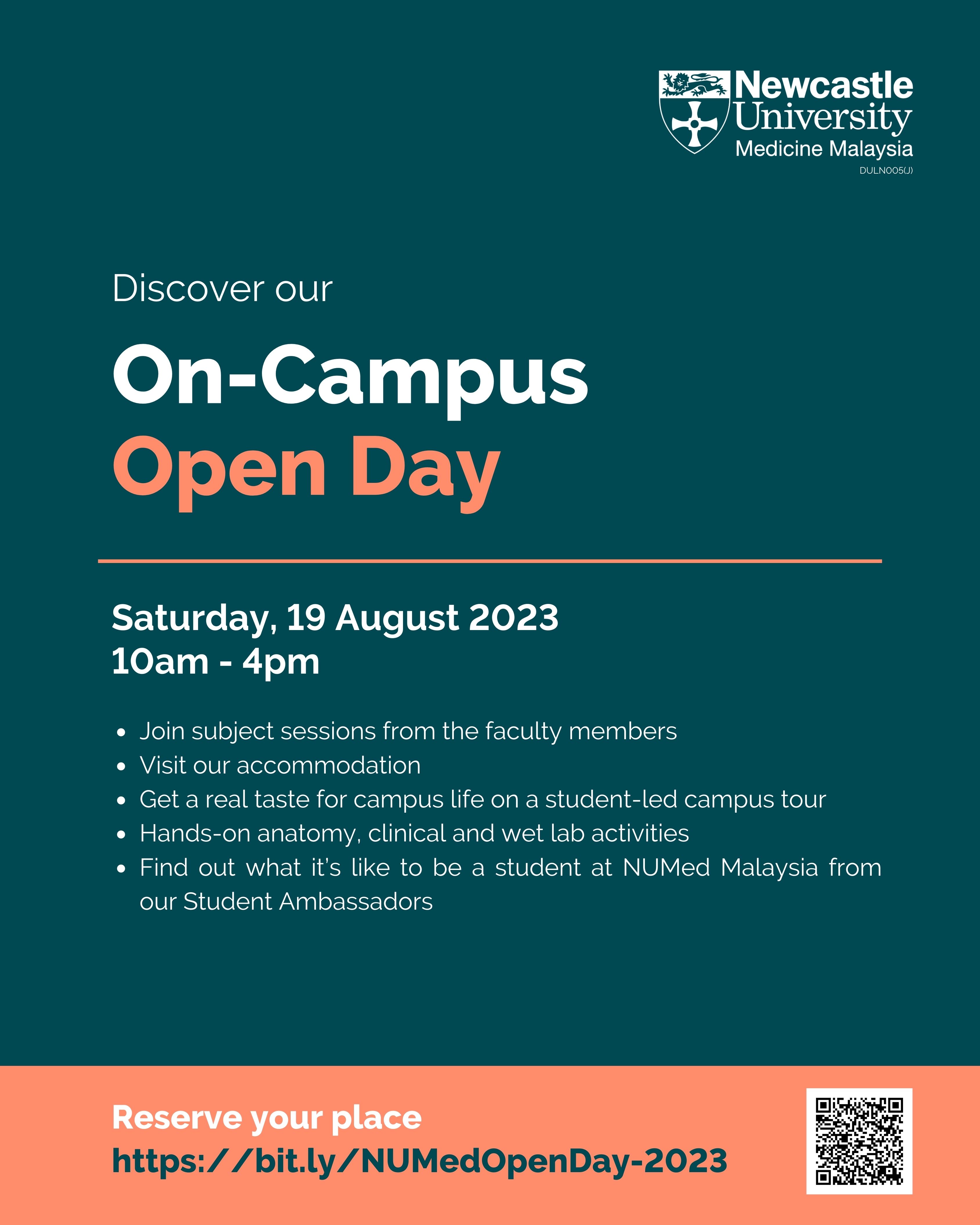




News from Institutions

